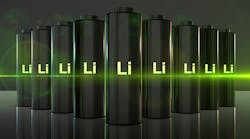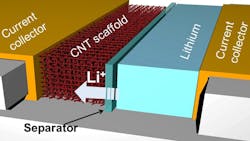At a Glance:
- Eliminating the cobalt—the “blood diamond of batteries”—from Li-ion batteries could bring down production costs.
- Researchers at Texas A&M University are developing materials that prevent lithium-ion batteries from heating and failing.
- Recalls of millions of devices have been linked to materials used in lithium-ion batteries.
The global recall of the Samsung Galaxy Note7 due to battery malfunction (i.e., blowing up) is behind us, but the fiasco’s damaging effects remain in the collective memory of component manufacturers.
That the threat of exploding phones would have airlines bar the affected phones from flights—and by some estimates, cost Samsung Electronics up to $17 billion in revenue from the production and recall—is an object lesson in what to avoid.
The exact cause of the debacle and the consequent freezing of production of the phone was linked to two factors: a battery defect and a manufacturing snafu. Not only would the device’s lithium-ion battery overheat and catch fire, but a manufacturer’s welding defect would also prompt the battery to short circuit and ignite. Those were the conclusions of an internal investigation in which 700 engineers tested more than 200,000 devices and 30,000 batteries, as well as reports from independent safety auditors UL, Exponent and TUV Rheinland.
Resolving issues with lithium-ion batteries are for the most part a bane for battery suppliers on the lookout for performance boosters and cost reductions. Nevertheless, recent developments in Li-ion battery production show promise on at least two fronts: making batteries flame resistant, and reducing costs while boosting performance.
Making Batteries Flame Resistant
Lithium-ion batteries have a tendency to overheat. Researchers at Texas A&M University working on technology that prevent lithium batteries from heating and failing have designed anodes (electrical conductors that release electrons during discharge) using highly conductive, lightweight materials called carbon nanotubes. The new anode architecture enables safe storage of large quantities of lithium ions.
The researchers found that 3D porous carbon nanotube structures with an optimum quantity of binding molecules prevented the formation of dendrites, the needle-like structures that have been known to cause a short circuit, failure or fire. Dendrites, which resemble stalagmites and grow on the surface of the anode, can pierce the separator inside the battery.
Dr. Choongho Yu, associate professor, J. Mike Walker ’66 Department of Mechanical Engineering at Texas A&M University, said developing the new “housing” is a key finding as the new material is a porous structure that can accommodate the lithium. “Dendrites can stay inside the ‘house’ instead of puncturing the separator to cause a short circuit and catch fire,” he said.
Moreover, Yu explained that as a vast quantity of lithium ions bind and spread along the surface of the carbon nanotube scaffold, it boosted the battery’s ability to produce large, sustained currents. What’s promising is that the new anode structure can handle currents five times more than commercially-available lithium batteries. This feature will prove useful for “large-scale batteries, such as those used in electric cars, that require quick charging,” noted Juran Noh, a material sciences graduate student in Yu’s laboratory in the J. Mike Walker ’66 Department of Mechanical Engineering.
The research, published in the journal Nano Letters, will bring the industry one step closer to designing flame-resistant Li-ion batteries for commercial applications, Yu said.
Reducing Costs While Boosting Performance
In separate research, the Cockrell School of Engineering at the University of Texas (UT) at Austin has been looking into developing a cobalt-free high-energy lithium-ion battery. Eliminating the cobalt—which some refer to as the “blood diamond of batteries” for its association with human rights violations, including child mining in the Democratic Republic of Congo—will reduce the costs of producing lithium-ion batteries.
Cobalt is typically housed in cathodes (the electrodes that absorb the electrons in the battery). The UT research team has instead devised a new class of cathodes anchored by nickel (89%), manganese and aluminum. More nickel in a battery means more energy storage. According to the research team, the increased energy density can lead to longer battery life for devices such as mobile phones and greater range for electric vehicles with each charge.
The challenge for scientists continues to be finding the optimal chemical balance: the batteries’ power output and energy storage should be balanced against stability, safety and lifespan. The downside of eliminating cobalt meant slowing down the kinetic response of a battery and lower rate capability (how quickly the cathode can be charged or discharged), but the University of Texas research team maintained that an optimal combination of metals and an even distribution of ions can overcome problems of short cycle life and poor rate capability.
Most cathodes for lithium-ion batteries use combinations of metal ions, such as nickel-manganese-cobalt (NMC) or nickel-cobalt-aluminum (NCA). The UT research team reported that cathodes can make up roughly half of the materials costs of the battery, at a price of about $28,500 per ton. Cobalt is more expensive than nickel, manganese and aluminum combined, and they noted it makes up 10% to 30% of most lithium-ion battery cathodes.
The UT researchers, whose findings are reported in the journal Advanced Materials, said they aimed to leverage industrial synthesis processes that are immediately scalable.
Driving Cobalt-Free
Demand for cobalt in the battery sector is correlated with the demand for electric vehicles. Top battery makers have committed to reduce cobalt content in lithium batteries, largely owing to ethical and cost efficiency concerns.
As an example, Tesla’s battery supplier Panasonic Corp. has vowed to achieve zero usage in future. Panasonic and Tesla jointly produce nickel-cobalt-aluminum (NCA) batteries at Tesla’s Gigafactory in Nevada.
Meanwhile, in an effort to lower the cost of its electric vehicles, Tesla has reportedly been in talks with Chinese battery maker Contemporary Amperex Technology Co. Ltd. (CATL) to make cobalt-free batteries for Tesla Model 3 vehicles built at the Tesla Gigafactory Shanghai.


